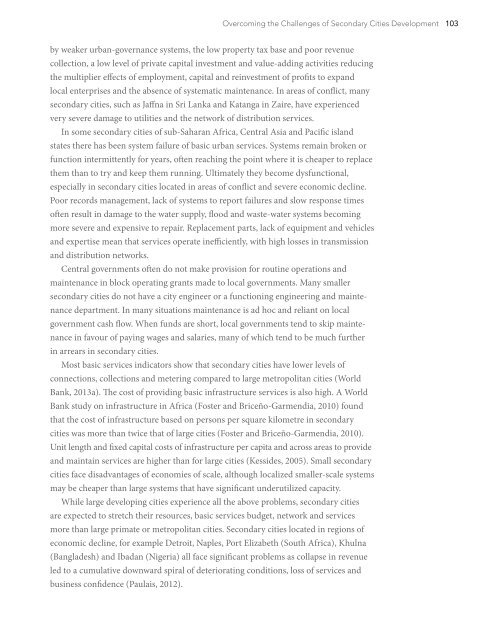DYhWN
DYhWN
DYhWN
You also want an ePaper? Increase the reach of your titles
YUMPU automatically turns print PDFs into web optimized ePapers that Google loves.
Overcoming the Challenges of Secondary Cities Development 103by weaker urban-governance systems, the low property tax base and poor revenuecollection, a low level of private capital investment and value-adding activities reducingthe multiplier effects of employment, capital and reinvestment of profits to expandlocal enterprises and the absence of systematic maintenance. In areas of conflict, manysecondary cities, such as Jaffna in Sri Lanka and Katanga in Zaire, have experiencedvery severe damage to utilities and the network of distribution services.In some secondary cities of sub-Saharan Africa, Central Asia and Pacific islandstates there has been system failure of basic urban services. Systems remain broken orfunction intermittently for years, often reaching the point where it is cheaper to replacethem than to try and keep them running. Ultimately they become dysfunctional,especially in secondary cities located in areas of conflict and severe economic decline.Poor records management, lack of systems to report failures and slow response timesoften result in damage to the water supply, flood and waste-water systems becomingmore severe and expensive to repair. Replacement parts, lack of equipment and vehiclesand expertise mean that services operate inefficiently, with high losses in transmissionand distribution networks.Central governments often do not make provision for routine operations andmaintenance in block operating grants made to local governments. Many smallersecondary cities do not have a city engineer or a functioning engineering and maintenancedepartment. In many situations maintenance is ad hoc and reliant on localgovernment cash flow. When funds are short, local governments tend to skip maintenancein favour of paying wages and salaries, many of which tend to be much furtherin arrears in secondary cities.Most basic services indicators show that secondary cities have lower levels ofconnections, collections and metering compared to large metropolitan cities (WorldBank, 2013a). The cost of providing basic infrastructure services is also high. A WorldBank study on infrastructure in Africa (Foster and Briceño-Garmendia, 2010) foundthat the cost of infrastructure based on persons per square kilometre in secondarycities was more than twice that of large cities (Foster and Briceño-Garmendia, 2010).Unit length and fixed capital costs of infrastructure per capita and across areas to provideand maintain services are higher than for large cities (Kessides, 2005). Small secondarycities face disadvantages of economies of scale, although localized smaller-scale systemsmay be cheaper than large systems that have significant underutilized capacity.While large developing cities experience all the above problems, secondary citiesare expected to stretch their resources, basic services budget, network and servicesmore than large primate or metropolitan cities. Secondary cities located in regions ofeconomic decline, for example Detroit, Naples, Port Elizabeth (South Africa), Khulna(Bangladesh) and Ibadan (Nigeria) all face significant problems as collapse in revenueled to a cumulative downward spiral of deteriorating conditions, loss of services andbusiness confidence (Paulais, 2012).


